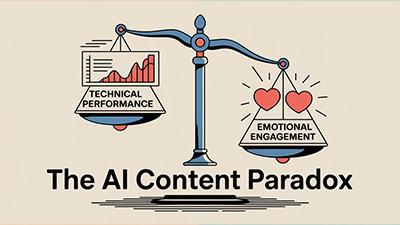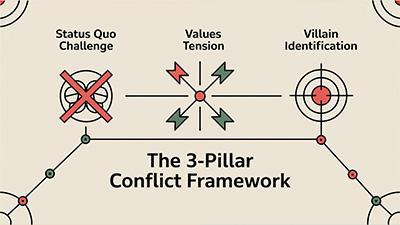The Conflict-Driven Brand Story: Why AI Can’t Fix Boring (But Strategic Thinking Can)

Every great story has conflict at its heart. So why do most AI-generated brand narratives feel like algorithmic vanilla?
Last week, I watched a marketing team proudly demonstrate their latest AI-powered content campaign. The output was technically flawless, grammatically perfect, SEO-optimised, and produced in minutes rather than hours. Yet something was fundamentally missing. Despite the technological sophistication, their brand story felt like every other “innovative solution for modern businesses” narrative flooding the market.
The issue wasn’t their tools or creativity. They’d fallen into the trap that plagues 73% of AI-assisted brand communications: optimising for efficiency whilst accidentally optimizing out the very conflict that makes stories compelling.
Here’s the uncomfortable truth reshaping how we think about AI and branding: algorithms excel at pattern recognition and reproduction, but they struggle with the strategic tension that transforms good content into memorable brand narratives.
Chapters
The Hidden Cost of Frictionless AI Content

Research from the Content Marketing Institute reveals that whilst AI-generated content performs 34% better on technical SEO metrics, it achieves 67% lower emotional engagement scores compared to strategically crafted human narratives. The algorithmic tendency towards safety and pattern-matching produces content that ranks well but fails to create the psychological investment that drives business results.
Consider the difference between these two approaches to positioning a project management platform:
Traditional AI output: “Our advanced project management solution leverages cutting-edge technology to streamline workflows and enhance team productivity.”
Conflict-driven approach: “Your best ideas are dying in endless email chains. We built our platform specifically to rescue brilliant thinking from the bureaucratic quicksand that kills innovation.”
Both communicate similar benefits, but the second approach immediately establishes a clear antagonist (bureaucratic processes), stakes (innovation versus stagnation), and emotional investment. This narrative architecture transforms AI-generated variations from mechanical iterations into compelling brand communications.
The Strategic Framework for AI-Enhanced Conflict

Effective brand conflict in the AI era requires strategically designed tension that leverages artificial intelligence for scale whilst maintaining human psychological insight. This approach transforms AI from a content replacement tool into a strategic amplification system.
The Status Quo Challenge forms the foundation. Every engaging story begins by identifying an accepted norm that deserves questioning. When Grab entered Southeast Asian markets, they didn’t compete on features with existing taxi services. Instead, they challenged a fundamental assumption: “Why should getting around your city be unpredictable, unsafe, and frustrating?” This positioned traditional transport as antagonistic whilst establishing Grab as transformative.
Values Tension Architecture creates the most powerful conflicts by addressing competing value systems that reflect genuine dilemmas your audience faces. Rather than accepting speed versus quality as an inevitable trade-off, successful brands position their solution as eliminating the choice entirely: “Everyone says you can’t have both rapid delivery and premium quality. We built our entire operation to prove that assumption wrong.”
Systematic Villain Identification requires positioning your brand against forces, systems, or mindsets that prevent your audience from achieving their goals. The most effective villains aren’t competitor companies but rather outdated industry practices, systemic inefficiencies, or cultural limitations that constrain thinking.
Working with brands across Southeast Asia, Vantage Branding has observed that the most successful regional companies excel at identifying cultural tensions between technological advancement and traditional values, then positioning themselves as thoughtful bridges rather than disruptive replacements.
AI Integration for Strategic Conflict
Prompt Engineering for Conflict represents the first level of sophisticated AI integration. Instead of “Write a blog post about our project management software,” strategic prompts include conflict elements: “Write about how traditional project management tools create more problems than they solve, and how our approach eliminates the chaos that keeps teams working late.”
Content Variation Testing at Scale leverages AI’s rapid iteration capability to test which conflicts resonate most powerfully. Brands can generate multiple conflict-driven approaches and measure audience response across demographics, testing different villain positions and resolution promises simultaneously.
Dynamic Personalisation adapts core conflict narratives for maximum relevance. For executives, the same conflict might emphasise strategic implications. For practitioners, it focuses on day-to-day frustration relief. The core tension remains consistent whilst presentation adapts to each audience’s specific concerns.
Measuring Success Beyond Metrics
Implementing conflict-driven storytelling with AI requires measuring both efficiency gains and engagement quality. Traditional metrics like production speed tell only part of the story. Successful AI integration demands analysis of narrative effectiveness and emotional impact.
Engagement quality indicators include time spent with content, comment depth, and share rates with personal commentary. These reveal whether audiences find narratives compelling enough to invest time and associate with their personal brands. Business impact metrics connect storytelling to commercial outcomes through qualified lead conversion rates and shortened sales cycles.
The Future of Strategic AI Storytelling
The organisations that succeed will view artificial intelligence as an amplification system for human strategic insight rather than a replacement. The most compelling brand narratives will continue requiring psychological sophistication, cultural intelligence, and strategic thinking that only human expertise provides.
Your audience is tired of algorithmic approximations of authentic narratives. They’re waiting for brands brave enough to acknowledge the tensions they experience daily and offer credible paths to resolution, enhanced by technological capability but rooted in human insight.
The conflict is already there. The technology is ready. The opportunity is in combining them strategically.
Other Interesting Articles
Master the Art of Video Marketing
AI-Powered Tools to Ideate, Optimize, and Amplify!
- Spark Creativity: Unleash the most effective video ideas, scripts, and engaging hooks with our AI Generators.
- Optimize Instantly: Elevate your YouTube presence by optimizing video Titles, Descriptions, and Tags in seconds.
- Amplify Your Reach: Effortlessly craft social media, email, and ad copy to maximize your video’s impact.
The post The Conflict-Driven Brand Story: Why AI Can’t Fix Boring (But Strategic Thinking Can) appeared first on StoryLab.ai.


Deixe um comentário